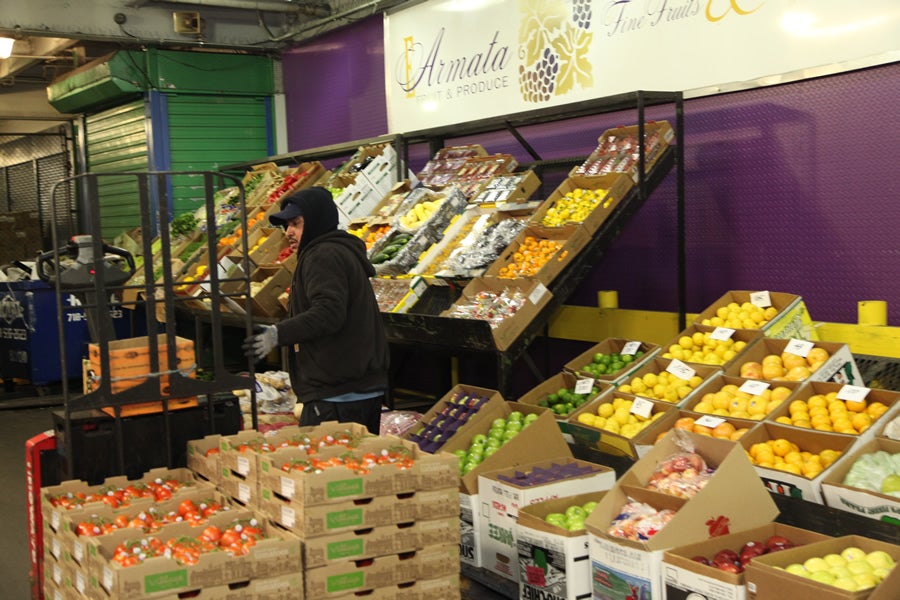Uncategorized
At Hunts Point, Teamsters Produce

There’s a sprawling area in an industrial neighborhood in the Bronx that isn’t on the radar for tourists. While it may not be a well-known destination, it’s the lifeblood of the New York City region.
Hunts Point Produce Market, a wholesale market in the Bronx in New York City, is the largest produce market in the world. It’s the source for more than 60 percent of the area’s produce and the independent wholesale food businesses in the market supply food to more than 22 million people in the New York metro area.
“A big part of New York City’s culture is food, and this place is vital to that,” said Dan Kane Jr., President of Local 202, which represents Teamsters at the market and whose offices are in the market itself.
The market sits on 113 acres, which includes 1 million feet of interior space, and generates approximately $2.4 billion in sales annually. Every day, produce is delivered fresh via tractor-trailer, train, boat and plane from 49 states and 55 countries, and is a key outlet for regional farmers.
It’s more than just a produce market. It’s a place of opportunity for those willing to work hard. It’s a place that has provided sustenance for New York families, both literally and figuratively.
Kane started working at the market himself about 30 years ago, and many of his co-workers at the local also started their Teamster careers loading and unloading produce there. In fact, Kane’s grandfather started work at the market in the 1930s.
“The market has been a good success story for the middle class. It’s a public market but the business owners are private and it’s a good partnership,” Kane said. “Teamsters work hand in hand with the Hunts Point Produce Trade Association (made up of approximately 40 employers at the market) to make this a place where generations can work.”
1,300 Teamsters
Of the more than 10,000 people employed at the market, more than 1,300 of them are Teamsters. Teamsters at the market work as warehousemen, truckers, supervisors and salesmen.
“There are hundreds of nationalities working at the market, many of them immigrants,” Kane said. “Most work in the Bronx.”
Many of the workers told a similar story about how they started working as Teamsters at Hunts Point Market.
“I started here one summer never thinking I’d be here this long,” said Frank Albano, a Teamster seller at the market. “I’ve been working here 27 years now. It’s a great job and we’ve got a great union in Local 202.”
Larry Perez, who works in strawberries, started at the warehouse in the market 20 years ago. “I like the union, and I love that my son is now a member, too!” he said.
“The union has really helped me out…it has helped all of us out,” said Abraham Cardone, a four-year Teamster at the market, gesturing behind him, taking in the hum of workers on a recent, rainy October at 5 a.m.
Work starts early in the morning for these workers in a blur of hand trucks, exhaust and truck horns, and the Teamster shirts are everywhere. Further into the market, the Teamster jackets and hats are put on in the refrigeration rooms.
Diversity
“Without this market, produce would be more expensive and there would be far less food diversity around here,” Kane said.
And diversity is something the market has, both in terms of workers and produce. The market’s wares change depending on the season, but a recent visit showcased dozens of varieties of mushrooms, apples and peppers, squash of every color and texture, mountains of potatoes, baskets of chestnuts, figs and cactus, tons of pumpkins, bushels of sugarcane, beets, guava, greens of every variety and countless other fruits and vegetables.
For all the diversity of produce, though, the workers share a common trait: They work hard.
“For their hard work, they get good working conditions and benefits. This isn’t an easy job and it’s a job that requires innate intelligence. These members understand the economy and we’re straight with them. They’re highly productive workers,” Kane said. “This market is an economic engine for thousands of families and it’s a long-term investment that New York City should be taking care of.”
Currently, the market and the city are working together to develop a long-term plan for a more modernized facility and to secure sources of funding.
“We’re trying to nurture this for the next generation,” Kane said.